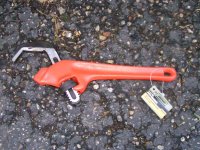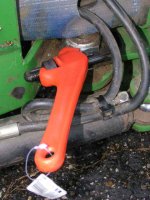MossRoad
Super Moderator
- Joined
- Aug 31, 2001
- Messages
- 60,216
- Location
- South Bend, Indiana (near)
- Tractor
- Power Trac PT425 2001 Model Year
I found an affordable wrench for the center pivot nut on the PT425 that we have talked about before. As you may or may not recall, there is one big honkin nut in the center pivot that has to be tightened on occasion. I found this adjustable wrench at TSC in the lose tool bins that seem to always be blocking the cash register lanes. See attached. It was $8.54 plus tax.
It works fine. I was able to turn the nut about 1/2 face, flip the wrench over and turn it the next 1/2 face. I used a piece of steel tubing as an extension, as the handle is too short for much leverage. You just have to watch out for the hydraulic hoses on the steering cylinger.
Mine was about 3 faces lose. I could feel it bouncing the sections when driving and could see the two halves flex a tiny bit when pushing down on the FEL.
It works fine. I was able to turn the nut about 1/2 face, flip the wrench over and turn it the next 1/2 face. I used a piece of steel tubing as an extension, as the handle is too short for much leverage. You just have to watch out for the hydraulic hoses on the steering cylinger.
Mine was about 3 faces lose. I could feel it bouncing the sections when driving and could see the two halves flex a tiny bit when pushing down on the FEL.

